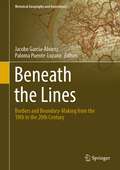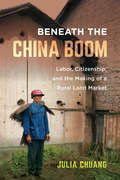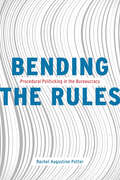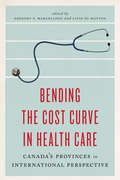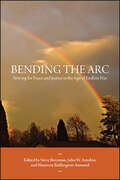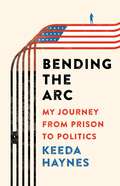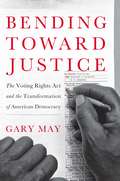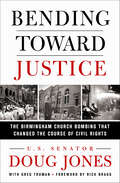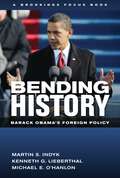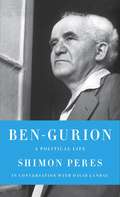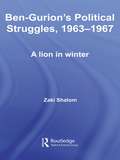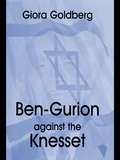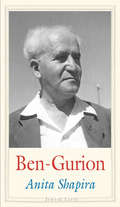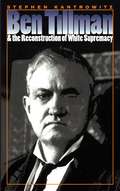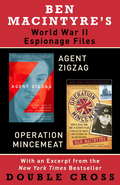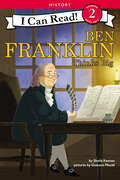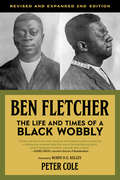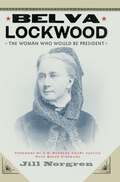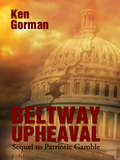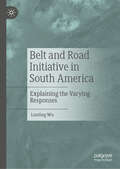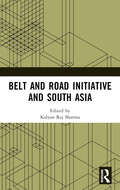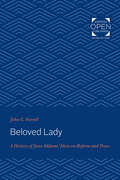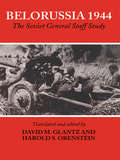- Table View
- List View
Beneath the Lines: Borders and Boundary-Making from the 18th to the 20th Century (Historical Geography and Geosciences)
by Jacobo García-Álvarez Paloma Puente-LozanoThis book brings together ten empirically rich and theoretically informed contributions that aim to clarify both geo-historical specificities and common transnational and global features of the cultures and practices of boundary making that shaped modern statehood. Written by scholars from Spain, France, Italy, Argentina, Brazil and Mexico, the essays included in this volume provide a comparative international perspective on the processes of border formation, as well as an integrative approach that seeks to strengthen the links between renewed geo-historical studies and more contemporary-oriented border studies. The book is addressed to a wide range of researchers, including geographers, historians, political scientists and specialists in geopolitics and the history of international relations.
Beneath the China Boom: Labor, Citizenship, and the Making of a Rural Land Market
by Julia ChuangFor nearly four decades, China’s manufacturing boom has been powered by the labor of 287 million rural migrant workers, who travel seasonally between villages where they farm for subsistence and cities where they work. Yet recently local governments have moved away from manufacturing and toward urban expansion and construction as a development strategy. As a result, at least 88 million rural people to date have lost rights to village land. In Beneath the China Boom, Julia Chuang follows the trajectories of rural workers, who were once supported by a village welfare state and are now landless. This book provides a view of the undertow of China’s economic success, and the periodic crises—a rural fiscal crisis, a runaway urbanization—that it first created and now must resolve.
Bending the Rules: Procedural Politicking in the Bureaucracy
by Rachel Augustine PotterWho determines the fuel standards for our cars? What about whether Plan B, the morning-after pill, is sold at the local pharmacy? Many people assume such important and controversial policy decisions originate in the halls of Congress. But the choreographed actions of Congress and the president account for only a small portion of the laws created in the United States. By some estimates, more than ninety percent of law is created by administrative rules issued by federal agencies like the Environmental Protection Agency and the Department of Health and Human Services, where unelected bureaucrats with particular policy goals and preferences respond to the incentives created by a complex, procedure-bound rulemaking process. With Bending the Rules, Rachel Augustine Potter shows that rulemaking is not the rote administrative activity it is commonly imagined to be but rather an intensely political activity in its own right. Because rulemaking occurs in a separation of powers system, bureaucrats are not free to implement their preferred policies unimpeded: the president, Congress, and the courts can all get involved in the process, often at the bidding of affected interest groups. However, rather than capitulating to demands, bureaucrats routinely employ “procedural politicking,” using their deep knowledge of the process to strategically insulate their proposals from political scrutiny and interference. Tracing the rulemaking process from when an agency first begins working on a rule to when it completes that regulatory action, Potter shows how bureaucrats use procedures to resist interference from Congress, the President, and the courts at each stage of the process. This exercise reveals that unelected bureaucrats wield considerable influence over the direction of public policy in the United States.
Bending the Cost Curve in Health Care: Canada's Provinces In International Perspective (The\johnson-shoyama Series On Public Policy Ser.)
by Gregory P. Marchildon Livio Di MatteoThrough Canadian and international perspectives, Bending the Cost Curve in Health Care explores the management of growing health costs in an extraordinarily complex arena. The book moves beyond previous debates, agreeing that while efficiencies and better value for money may yet be found, more fundamental reforms to the management and delivery of health services are essential prerequisites to bending the cost curve in the long run. While there is considerable controversy over direction and details of change, there also remains the challenge of getting agreement on the values or principles that would guide the reshaping of the policies, the structures, and the regulatory environment of health care in Canada. Leading experts from around the world representing a range of disciplines and professional backgrounds come together to organize and define the problems faced by policy-makers. Case studies from the United States, the United Kingdom, Australia, the Nordic countries, and industrialized Asian countries such as Taiwan offer useful reform experiences for provincial governments in Canada. Finally, common Canadian cost factors, such as pharmaceuticals and technology, and paying the health workforce, are explored. This book is the first volume in The Johnson-Shoyama Series on Public Policy, published by the University of Toronto Press in association with the Johnson-Shoyama Graduate School of Public Policy, an interdisciplinary centre for research, teaching, and executive training with campuses at the Universities of Regina and Saskatchewan.
Bending the Arc: Striving for Peace and Justice in the Age of Endless War
by Steve Breyman; John W. Amidon; Maureen Baillargeon AumandSince the late 1990s the annual Kateri Tekakwitha Interfaith Peace Conference in upstate New York has grown to become the region's premier peace conference. Bending the Arc provides a history of the conference and brings together the inspiring, personal stories from such well-known participants as Medea Benjamin, Blase Bonpane, Kathy Kelly, Bill Quigley, David Swanson, and Ann Wright, among others. Drawing from diverse philosophical and spiritual traditions, contributors share their experiences of working for peace and justice and discuss the obstacles to both. They address a wide range of contemporary problems, including the war on terror, killer drones, the invasions and occupations of Afghanistan and Iraq, mass surveillance, the human cost of war, political-economic impediments to peace, violent extremism, the role of women in peace-building, and the continued threat of nuclear weapons. With its stories of how peace activists found their calling and its exploration of why the world still needs peace activism, the book offers a vision rooted in human community and hope for the future.
Bending the Arc: My Journey from Prison to Politics
by Keeda J. HaynesA searing exposé of the profound failures in our justice system, told by a woman who has journeyed from wrongfully accused prisoner to acclaimed public defender Keeda Haynes was a Girl Scout and a churchgoer, but after college graduation, she was imprisoned for a crime she didn&’t commit. Her boyfriend had asked her to sign for some packages—packages she did not know were filled with marijuana. As a young Black woman falsely accused, prosecuted, and ultimately imprisoned, Haynes suffered the abuses of our racist and sexist justice system. But rather than give in to despair, she decided to fight for change. After her release, she attended law school at night, became a public defender, and ultimately staged a highly publicized campaign for Congress. At every turn of her unlikely story, she gives unique insights into the inequities built into our institutions. In the end, despite the injustice she endured, she emerges convinced that ours can become a true second-chance culture.
Bending Toward Justice: The Voting Rights Act and the Transformation of American Democracy
by Gary MayWhen the Fifteenth Amendment of 1870 granted African Americans the right to vote, it seemed as if a new era of political equality was at hand. Before long, however, white segregationists across the South counterattacked, driving their black countrymen from the polls through a combination of sheer terror and insidious devices such as complex literacy tests and expensive poll taxes. Most African Americans would remain voiceless for nearly a century more, citizens in name only until the passage of the 1965 Voting Rights Act secured their access to the ballot. In "Bending Toward Justice," celebrated historian Gary May describes how black voters overcame centuries of bigotry to secure and preserve one of their most important rights as American citizens. The struggle that culminated in the passage of the Voting Rights Act was long and torturous, and only succeeded because of the courageous work of local freedom fighters and national civil rights leadersOCoas well as, ironically, the opposition of Southern segregationists and law enforcement officials, who won public sympathy for the voting rights movement by brutally attacking peaceful demonstrators. But while the Voting Rights Act represented an unqualified victory over such forces of hate, May explains that its achievements remain in jeopardy. Many argue that the 2008 election of President Barack Obama rendered the act obsolete, yet recent years have seen renewed efforts to curb voting rights and deny minorities the actOCOs hard-won protections. Legal challenges to key sections of the act may soon lead the Supreme Court to declare those protections unconstitutional. A vivid, fast-paced history of this landmark piece of civil rights legislation, "Bending Toward Justice" offers a dramatic, timely account of the struggle that finally won African Americans the ballotOCoalthough, as May shows, the fight for voting rights is by no means over. "
Bending Toward Justice: The Birmingham Church Bombing That Changed the Course of Civil Rights
by Doug Jones Greg TrumanThe story of the decades-long fight to bring justice to the victims of the 16th Street Baptist Church bombing, culminating in Sen. Doug Jones' prosecution of the last living bombers. On September 15, 1963, the 16th Street Baptist Church in Birmingham, Alabama was bombed. The blast killed four young girls and injured twenty-two others. The FBI suspected four particularly radical Ku Klux Klan members. Yet due to reluctant witnesses, a lack of physical evidence, and pervasive racial prejudice the case was closed without any indictments.But as Martin Luther King, Jr. famously expressed it, "the arc of the moral universe is long, but it bends toward justice." Years later, Alabama Attorney General William Baxley reopened the case, ultimately convicting one of the bombers in 1977. Another suspect passed away in 1994, and US Attorney Doug Jones tried and convicted the final two in 2001 and 2002, representing the correction of an outrageous miscarriage of justice nearly forty years in the making. Jones himself went on to win election as Alabama’s first Democratic Senator since 1992 in a dramatic race against Republican challenger Roy Moore.Bending Toward Justice is a dramatic and compulsively readable account of a key moment in our long national struggle for equality, related by an author who played a major role in these events. A distinguished work of legal and personal history, the book is destined to take its place as a canonical civil rights history.
Bending History
by Michael E. O'Hanlon Kenneth G. Lieberthal Martin S. IndykBy the time of Barack Obama's inauguration as the 44th president of the United States, he had already developed an ambitious foreign policy vision. By his own account, he sought to bend the arc of history toward greater justice, freedom, and peace; within a year he was awarded the Nobel Peace Prize, largely for that promise.In Bending History, Martin Indyk, Kenneth Lieberthal, and Michael O'Hanlon measure Obama not only against the record of his predecessors and the immediate challenges of the day, but also against his own soaring rhetoric and inspiring goals. Bending History assesses the considerable accomplishments as well as the failures and seeks to explain what has happened.Obama's best work has been on major and pressing foreign policy challenges--counterterrorism policy, including the daring raid that eliminated Osama bin Laden; the "reset" with Russia; managing the increasingly significant relationship with China; and handling the rogue states of Iran and North Korea. Policy on resolving the Israeli-Palestinian conflict, however, has reflected serious flaws in both strategy and execution. Afghanistan policy has been plagued by inconsistent messaging and teamwork. On important "softer" security issues--from energy and climate policy to problems in Africa and Mexico--the record is mixed. As for his early aspiration to reshape the international order, according greater roles and responsibilities to rising powers, Obama's efforts have been wellconceived but of limited effectiveness.On issues of secondary importance, Obama has been disciplined in avoiding fruitless disputes (as with Chavez in Venezuela and Castro in Cuba) and insisting that others take the lead (as with Qaddafi in Libya). Notwithstanding several missteps, he has generally managed well the complex challenges of the Arab awakenings, striving to strike the right balance between U.S. values and interests.The authors see Obama's foreign policy to date as a triumph of discipline and realism over ideology. He has been neither the transformative beacon his devotees have wanted, nor the weak apologist for America that his critics allege. They conclude that his grand strategy for promoting American interests in a tumultuous world may only now be emerging, and may yet be curtailed by conflict with Iran. Most of all, they argue that he or his successor will have to embrace U.S. economic renewal as the core foreign policy and national security challenge of the future.
Bending History
by Michael E. O'Hanlon Kenneth G. Lieberthal Martin S. IndykBy the time of Barack Obama's inauguration as the 44th president of the United States, he had already developed an ambitious foreign policy vision. By his own account, he sought to bend the arc of history toward greater justice, freedom, and peace; within a year he was awarded the Nobel Peace Prize, largely for that promise.In Bending History, Martin Indyk, Kenneth Lieberthal, and Michael O'Hanlon measure Obama not only against the record of his predecessors and the immediate challenges of the day, but also against his own soaring rhetoric and inspiring goals. Bending History assesses the considerable accomplishments as well as the failures and seeks to explain what has happened.Obama's best work has been on major and pressing foreign policy challenges-counterterrorism policy, including the daring raid that eliminated Osama bin Laden; the "reset" with Russia; managing the increasingly significant relationship with China; and handling the rogue states of Iran and North Korea. Policy on resolving the Israeli-Palestinian conflict, however, has reflected serious flaws in both strategy and execution. Afghanistan policy has been plagued by inconsistent messaging and teamwork. On important "softer" security issues-from energy and climate policy to problems in Africa and Mexico-the record is mixed. As for his early aspiration to reshape the international order, according greater roles and responsibilities to rising powers, Obama's efforts have been well-conceived but of limited effectiveness.On issues of secondary importance, Obama has been disciplined in avoiding fruitless disputes (as with Chavez in Venezuela and Castro in Cuba) and insisting that others take the lead (as with Qaddafi in Libya). Notwithstanding several missteps, he has generally managed well the complex challenges of the Arab awakenings, striving to strike the right balance between U.S. values and interests.The authors see Obama's foreign policy to date as a triumph of discipline and realism over ideology. He has been neither the transformative beacon his devotees have wanted, nor the weak apologist for America that his critics allege. They conclude that his grand strategy for promoting American interests in a tumultuous world may only now be emerging, and may yet be curtailed by conflict with Iran. Most of all, they argue that he or his successor will have to embrace U.S. economic renewal as the core foreign policy and national security challenge of the future.
Ben-Gurion: A Political Life (Jewish Encounters Series)
by Shimon Peres David LandauIsrael's current president gives us a dramatic and revelatory biography of Israel's founding father and first prime minister. Shimon Peres was in his early twenties when he first met David Ben-Gurion. Although the state that Ben-Gurion would lead through war and peace had not yet declared its precarious independence, the "Old Man," as he was called even then, was already a mythic figure. Peres, who came of age in the cabinets of Ben-Gurion, is uniquely placed to evoke this figure of stirring contradictions--a prophetic visionary and a canny pragmatist who early grasped the necessity of compromise for national survival. Ben-Gurion supported the 1947 United Nations Partition Plan for Palestine, though it meant surrendering a two-thousand-year-old dream of Jewish settlement in the entire land of Israel. He granted the Orthodox their first exemptions from military service despite his own deep secular commitments, and he reached out to Germany in the aftermath of the Holocaust, knowing that Israel would need as many strong alliances as possible within the European community. A protégé of Ben-Gurion and himself a legendary figure on the international political stage, Shimon Peres brings to his account of Ben-Gurion's life and towering achievements the profound insight of a statesman who shares Ben-Gurion's dream of a modern, democratic Jewish nation-state that lives in peace and security alongside its Arab neighbors. In Ben-Gurion, Peres sees a neglected model of leadership that Israel and the world desperately need in the twenty-first century.From the Hardcover edition.
Ben-Gurion's Political Struggles, 1963-1967: A Lion in Winter
by Zaky ShalomAn essential insight into this central figure in the modern history of Israel and Zionism. This important new study explores the years that built up to the Six Day War and details the crucial issues and events the world is still grappling with today. This book traces Daniel Ben-Gurion’s waning years in Israeli politics. After his resignation from the office of prime minister in 1963, the ‘Old Man’ soon lost faith in his self-chose successor, Levi Eshkol, and ceaselessly tried to undermine the latter’s premiership, eventually forming a breakaway party. The events leading up to the Six-Day War in June 1967 caught Ben-Gurion by surprise. During the weeks-long ‘waiting period’ prior to the outbreak of hostilities, he paid little attention to daily security issues. But when war did erupt, he displayed one of his key leadership skills – the ability to formulate an accurate, independent situation assessment. It will be of interest to scholars working in Israeli politics and history, this is a lucid, thoroughly researched account of the sunset years of the driving force behind the Israeli nation-state.
Ben-Gurion Against the Knesset
by Giora GoldbergThe power struggle between Ben-Gurion and the Knesset was not primarily concerned with who should hold the reins of power, but with the ideals that should lie behind government. Ben-Gurion did not think that the Knesset had the moral backbone required at a historic turning-point in Israeli history, when the character of the nation was being developed; although he conceded that it was capable of dealing with the more mundane administrative tasks. He therefore denied the Knesset the right to take part in the policy-making process, caused a decline in the support of the elite and the general public, encouraged partisanship, and endeavored to reduce competitiveness. Ben-Gurion was so dismissive of the Knesset and its members, that he would not even attend parties at which Knesset members were being given awards.
Ben-Gurion
by Anita ShapiraDavid Ben-Gurion cast a great shadow during his lifetime, and his legacy continues to be sharply debated to this day. There have been many books written about the life and accomplishments of the Zionist icon and founder of modern Israel, but this new biography by eminent Israeli historian Anita Shapira strives to get to the core of the complex man who would become the face of the new Jewish nation. Shapira tells the Ben-Gurion story anew, focusing especially on the period after 1948, during the first years of statehood. As a result of her extensive research and singular access to Ben-Gurion's personal archives, the author provides fascinating and original insights into his personal qualities and those that defined his political leadership. As Shapira writes, "Ben-Gurion liked to argue that history is made by the masses, not individuals. But just as Lenin brought the Bolshevik Revolution into the world and Churchill delivered a fighting Britain, so with Ben-Gurion and the Jewish state. He knew how to create and exploit the circumstances that made its birth possible. " Shapira's portrait reveals the flesh-and-blood man who more than anyone else realized the Israeli state.
Ben Tillman and the Reconstruction of White Supremacy
by Stephen KantrowitzThrough the life of Benjamin Ryan Tillman (1847-1918), South Carolina's self-styled agrarian rebel, this book traces the history of white male supremacy and its discontents from the era of plantation slavery to the age of Jim Crow.As an anti-Reconstruction guerrilla, Democratic activist, South Carolina governor, and U.S. senator, Tillman offered a vision of reform that was proudly white supremacist. In the name of white male militance, productivity, and solidarity, he justified lynching and disfranchised most of his state's black voters. His arguments and accomplishments rested on the premise that only productive and virtuous white men should govern and that federal power could never be trusted. Over the course of his career, Tillman faced down opponents ranging from agrarian radicals to aristocratic conservatives, from woman suffragists to black Republicans. His vision and his voice shaped the understandings of millions and helped create the violent, repressive world of the Jim Crow South.Friend and foe alike--and generations of historians--interpreted Tillman's physical and rhetorical violence in defense of white supremacy as a matter of racial and gender instinct. This book instead reveals that Tillman's white supremacy was a political program and social argument whose legacies continue to shape American life.
Ben Macintyre's World War II Espionage Files: Agent Zigzag, Operation Mincemeat
by Ben MacintyreAgent Zigzag and Operation Mincemeat, two thrilling accounts of World War II espionage, are available together as an ebook—with an excerpt from the New York Times bestseller Double Cross. &“Not since Ian Fleming and John le Carré has a spy writer so captivated readers.&”—The Hollywood ReporterAGENT ZIGZAG • &“Wildly improbably but entirely true . . . [a] compellingly cinematic spy thriller with verve.&”—Entertainment Weekly Eddie Chapman was a charming criminal, a con man, and a philanderer. He was also one of the most remarkable double agents Britain has ever produced. Inside the traitor was a man of loyalty; inside the villain was a hero. The problem for Chapman, his spymasters, and his lovers was to know where one persona ended and the other began. Based on recently declassified files, Agent Zigzag tells Chapman&’s full story for the first time. It&’s a gripping tale of loyalty, love, treachery, espionage, and the thin and shifting line between fidelity and betrayal. OPERATION MINCEMEANT • &“Brilliant and almost absurdly entertaining.&”—The New Yorker Near the end of World War II, two British naval officers came up with a brilliant and slightly mad scheme to mislead the Nazi armies about where the Allies would attack southern Europe. To carry out the plan, they would have to rely on the most unlikely of secret agents: a dead man. Ben Macintyre&’s dazzling, critically acclaimed bestseller chronicles the extraordinary story of what happened after British officials planted this dead body—outfitted in a British military uniform with a briefcase containing false intelligence documents—in Nazi territory, and how this secret mission fooled Hitler into changing military positioning, paving the way for the Allies to overtake the Nazis.
Ben Jonson's Walk to Scotland
by Julie Sanders James Loxley Anna Groundwater James Loxley Anna GroundwaterAt the heart of this book is a previously unpublished account of Ben Jonson's celebrated walk from London to Edinburgh in the summer of 1618. This unique firsthand narrative provides us with an insight into where Jonson went, whom he met, and what he did on the way. James Loxley, Anna Groundwater and Julie Sanders present a clear, readable and fully annotated edition of the text. An introduction and a series of contextual essays shed further light on topics including the evidence of provenance and authorship, Jonson's contacts throughout Britain, his celebrity status, and the relationships between his 'foot voyage' and other famous journeys of the time. The essays also illuminate wider issues such as early modern travel and political and cultural relations between England and Scotland. It is an invaluable volume for scholars and upper-level students of Ben Jonson studies, early modern literature, seventeenth-century social history, and cultural geography.
Ben Franklin Thinks Big (I Can Read Level 2)
by Sheila KeenanThe life of Ben Franklin, a key leader in the founding of the United States, is introduced in this early reader biography.Ben Franklin was a famous inventor, statesman, and writer who helped the thirteen colonies become the United States. From inventing the lightning rod to helping write the Declaration of Independence, his big ideas had a lasting impact on American history. Beginning readers will learn about the milestones in Ben Franklin’s life in this Level Two I Can Read biography. This biography includes bonus materials, complete with a timeline and historical illustrations, including Franklin’s electrical machine invention and his leaf print money that couldn’t be counterfeited.Ben Franklin Thinks Big is a Level Two I Can Read, geared for kids who read on their own but still need a little help. Whether shared at home or in a classroom, the engaging stories, longer sentences, and language play of Level Two books are proven to help kids take their next steps toward reading success.
Ben Fletcher: The Life and Times of a Black Wobbly (Labor Classics Ser.)
by Peter ColeIn the early twentieth century, when many US unions disgracefully excluded black and Asian workers, the Industrial Workers of the World (IWW) warmly welcomed people of color, in keeping with their emphasis on class solidarity and their bold motto: "An Injury to One Is an Injury to All!" Ben Fletcher: The Life and Times of a Black Wobbly tells the story of one of the greatest heroes of the American working class. A brilliant union organizer and a humorous orator, Benjamin Fletcher (1890–1949) was a tremendously important and well-loved African American member of the IWW during its heyday. Fletcher helped found and lead Local 8 of the IWW's Marine Transport Workers Industrial Union, unquestionably the most powerful interracial union of its era, taking a principled stand against all forms of xenophobia and exclusion. For years, acclaimed historian Peter Cole has carefully researched the life of Ben Fletcher, painstakingly uncovering a stunning range of documents related to this extraordinary man. It includes a detailed biographical sketch of his life and history, reminiscences by fellow workers who knew him, a chronicle of the IWW's impressive decade-long run on the Philadelphia waterfront in which Fletcher played a pivotal role, and nearly all of his known writings and speeches, thus giving Fletcher's timeless voice another opportunity to inspire a new generation of workers, organizers, and agitators. This revised and expanded second edition includes new materials such as facsimile reprints of two extremely rare pamphlets on racism from the early twentieth century, more information on his prison years and personal life, additional recollections from friends, greater consideration of Fletcher from a global perspective, and much more.
Belva Lockwood: The Woman Who Would Be President
by Jill NorgrenA legal historian recounts the influential life of the women&’s rights activist who was the first woman to practice at the bar of the Supreme Court. In Belva Lockwood: The Woman Who Would Be President, prize-winning legal historian Jill Norgren recounts, for the first time, the life story of one of the nineteenth century&’s most surprising and accomplished advocates for women&’s rights. As Norgren shows, Lockwood was fearless in confronting the male establishment, commanding the attention of presidents, members of Congress, influential writers, and everyday Americans. Obscured for too long in the historical shadow of her longtime colleague, Susan B. Anthony, Lockwood steps into the limelight at last in this engaging new biography. Born on a farm in upstate New York in 1830, Lockwood married young and reluctantly became a farmer&’s wife. After her husband&’s premature death, however, she earned a college degree, became a teacher, and moved to Washington, D.C., with plans to become an attorney-an occupation all but closed to women. Not only did she become one of the first female attorneys in the U.S., but in 1879 became the first woman ever allowed to practice at the bar of the Supreme Court. In 1884 Lockwood continued her trailblazing ways as the first woman to run a full campaign for the U.S. Presidency. She ran for President again in 1888. Although her candidacies were unsuccessful (as she knew they would be), Lockwood demonstrated that women could compete with men in the political arena. After these campaigns she worked tirelessly on behalf of the Universal Peace Union, hoping, until her death in 1917, that she, or the organization, would win the Nobel Peace Prize. Belva Lockwood deserves to be far better known. As Norgren notes, it is likely that Lockwood would be widely recognized today as a feminist pioneer if most of her personal papers had not been destroyed after her death. Fortunately for readers, Norgren shares much of her subject&’s tenacity and she has ensured Lockwood&’s rightful place in history with this meticulously researched and beautifully written book. Foreword by U.S. Supreme Court Justice Ruth Bader Ginsburg
Beltway Upheaval
by Kenneth GormanThe Country has experienced bizarre political events. First, a contingent election in the House of Representatives after no candidate for president garnered 270 electoral votes. Then, the victorious president resigned suddenly on Inauguration Day. Is President Granger guilty of concealing a secret about resigned President Atkinsen in order to succeed him? Speaker of the House Allcott despises Granger who "stole the presidency from me." Granger foresees a disastrous economic decline. He signs Executive Order 14914 to ward off a depression. Allcott condemns the EO and influences the House to Impeach Granger. The Senate decides Granger's fate. Is Allcott guilty of conspiracies? What is the fallout from the Executive Order? Unexpectedly, Granger takes a leave of absence. Who becomes acting president? BELTWAY UPHEAL is a fictional story of presidential actions and conflicts. Can real transformation happen?
Belt and Road Initiative in South America: Explaining the Varying Responses
by Lunting WuThis book is concerned with the varying responses of South American countries to the Belt and Road Initiative (BRI). Since Beijing launched the Belt and Road Initiative in 2013, 3/4 of countries in the world have engaged with China's arrangement of promoting global physical and digital connectivity. This still leaves a quarter of them that have refused China’s offer so far or withdrawn. How do we account for why countries chose to join the BRI while others do not? Research on South American countries’ responses to the BRI is scant, but the topic is pertinent. While the great-power competition and systemic rivalry have spoiled the appetite of European countries to intensify their ties with China, many developing countries seem to be rather interested. This book will interest scholars of international political economy, geopolitics, foreign policy and international development.
Belt and Road Initiative and South Asia
by Raj Kalyan SharmaBelt and Road Initiative (BRI) has been an obscure concept, and it remains difficult to distinguish what BRI is and isn’t, making it difficult for many governments and global corporations to properly participate in it. I am delighted to present the opinions and perspectives of many eminent researchers, professors and experts from various countries on the Belt and Road Initiative (BRI). The book contains 11 chapters which are written by distinguished researchers and practitioners from various parts of Asia. While these 11 chapters discuss the many characteristics of the BRI, including advantages and costs, they also convey the lessons that many other Southeast Asian countries have learned. Each chapter offers valueable lessons to the countries that have yet to participate in the initiatives.
Beloved Lady: A History of Jane Addams' Ideas on Reform and Peace (The Johns Hopkins University Studies in Historical and Political Science)
by John C. FarrellOriginally published in 1967. Jane Addams was one of the most creative thinkers and activists in the history of American social reform. She pioneered the settlement house movement. She was a leader in the attempt to relate education to the new urban environment for millions of Americans in the early twentieth century. She was a vocal advocate of the Progressive movement and active in the drive for women's rights. She was also an outstanding spokesman for international understanding and world peace. Although Jane Addams is well known as one of the originators of social work in the United States, as an early advocate of a "War on Poverty," and as the proponent of ideas that led to the creation of the modern welfare state, the convictions that motivated her prodigious energy had not, prior to Dr. Farrell's investigation, been carefully examined. He traces the relation between her philanthropic principles and her Progressive politics, her feminism, and her efforts to achieve world peace. He shows how her association with John Dewey and her acceptance of pragmatism changed her thinking and also how her later pacifism alienated her from many progressives of various persuasions. Before his sudden and untimely death at the age of thirty-two, John C. Farrell had just completed this study, based on his examination of virtually every important writing by and about Jane Addams. It is not a full-fledged biography but rather an intellectual history that seeks to explain the origins and relevance of Jane Addams' ideas and activities to the first half of the twentieth century. The manuscript for this book, complete but unrevised, was edited for publication by two of Farrell's colleagues who prefer to remain unidentified. Charles C. Barker, professor of history at Johns Hopkins University, wrote an introduction that places Beloved Lady in the context of scholarly literature on Jane Addams.
Belorussia 1944: The Soviet General Staff Study (Soviet (Russian) Study of War #No. 12)
by Harold S. Orenstein David M. GlantzA new edited translation of the Soviet Staff study of the Red Army's Belorussian operation in the summer of 1944, which was unprecedented in terms of its scale, scope and strategic consequences. The Soviet Stavka had planned a campaign consisting of a series of massive operations spanning the entire Soviet-German front. Four powerful fronts (army groups) operated under close Stavka (high command) control. Over 1.8 million troops acomplished a feat unique in the history of the Red Army: the defeat and dismemberment of an entire German army group. This book is a translation of the Soviet General Staff Study No 18, a work originally classified as 'secret' and intended to educate Soviet commanders and staff officers. The operation is presented from the Soviet perspective, in the words of the individuals who planned and orchestrated the plans. A map supplement, including terrain maps, is provided to illustrate the flow of the operation in greater detail.
